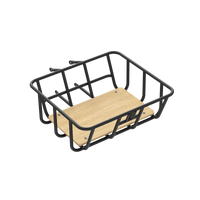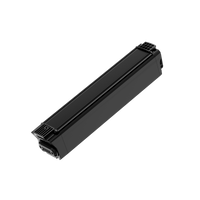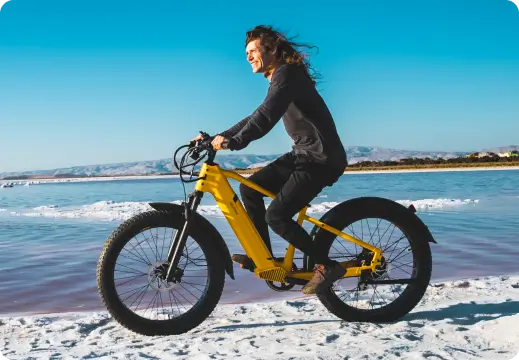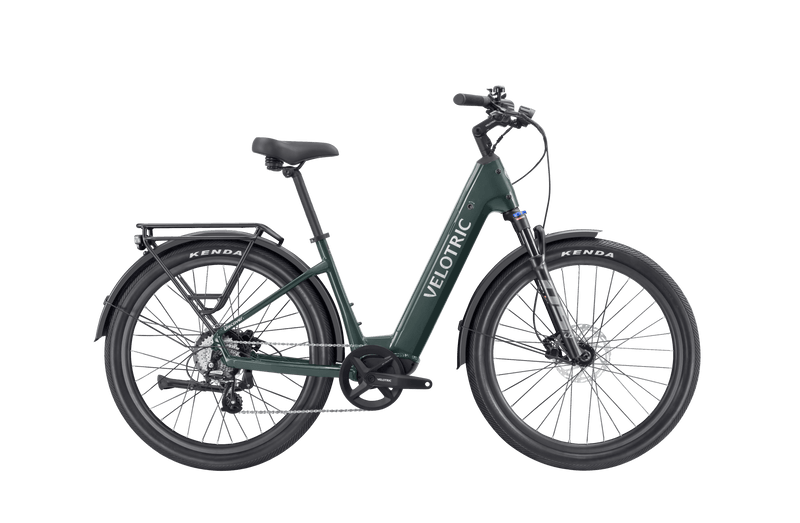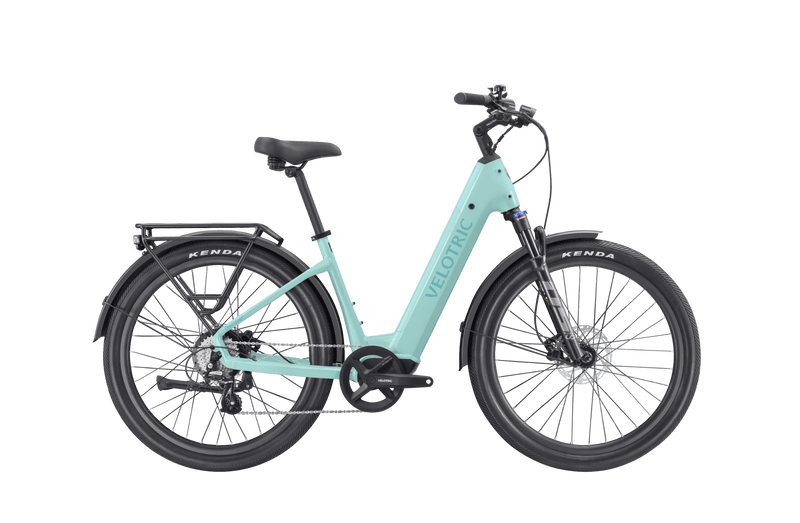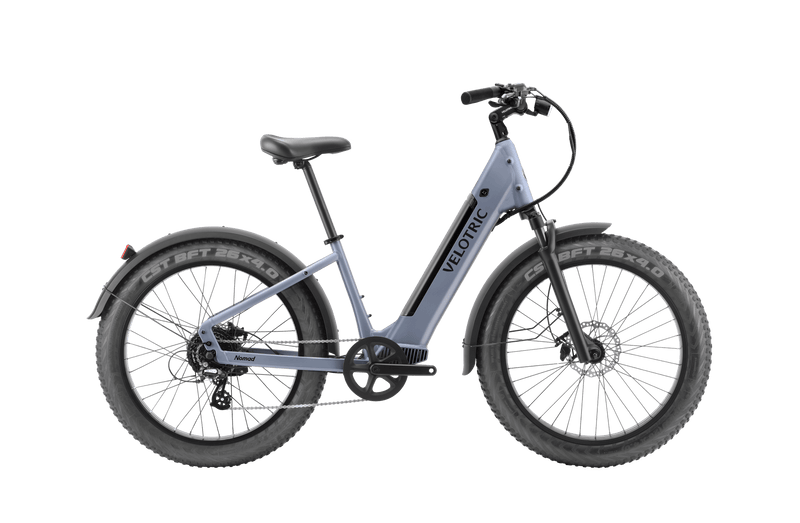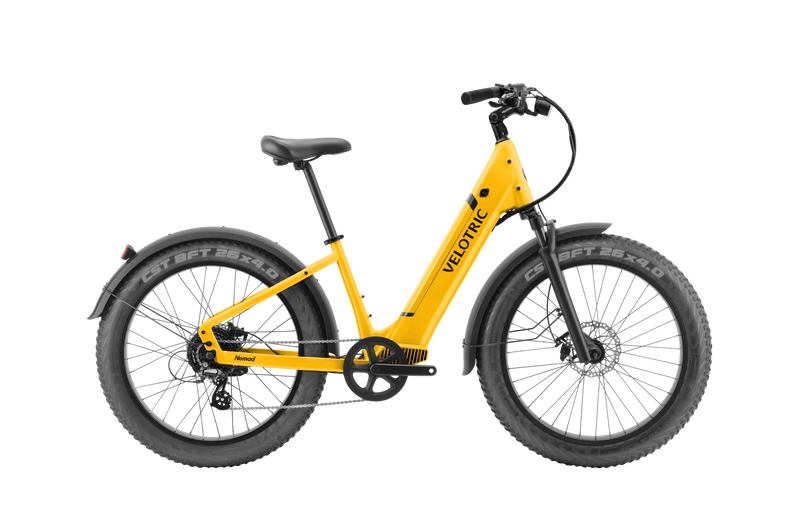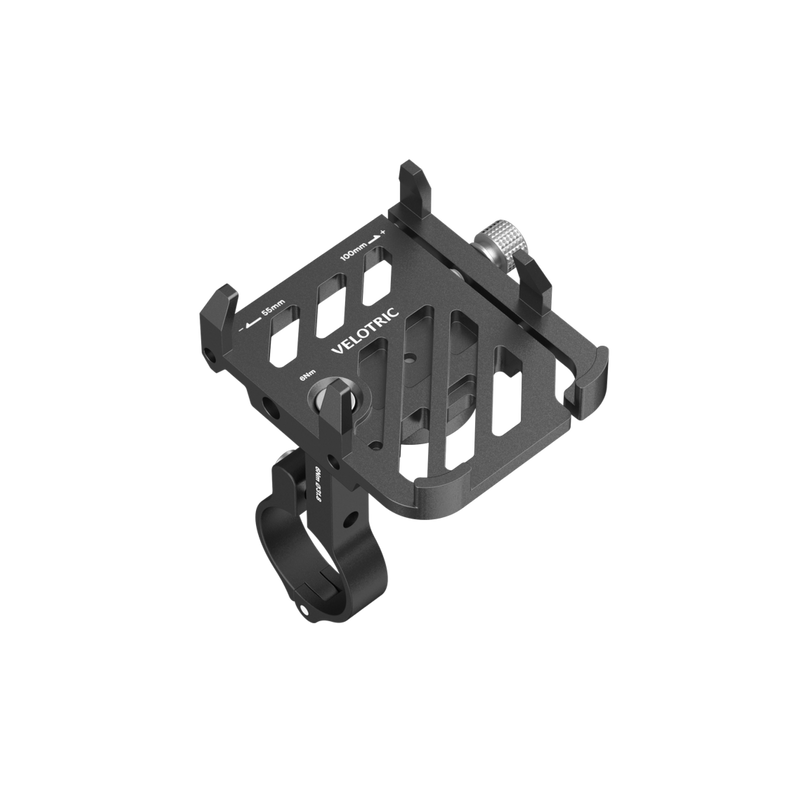If cycling along city streets sounds like a snooze and you’d rather explore the great outdoors than a concrete jungle, an all-terrain e-bike could be for you. All-terrain bikes (ATBs) are designed for rugged terrains, from dirt paths to gravel roads.
This makes ATBs great for people who like off-road riding. However, you can also ride them on paved surfaces. Thanks to their versatility, ATBs are becoming increasingly popular as bicyclists use them on all terrain.
When talking about electric ATBs, novice cyclists may assume they’re the same as an electric mountain bike (MTB). However, ATBs and MTBs are two types of bikes. Below, we reveal the difference. We also explain what to look for to get the best electric bike for your all-terrain needs.
What is an all-terrain e-bike?
An all-terrain electric bike is a type of e-bike designed for riding on rough terrain, including nature trails, unpaved dirt roads, and gravel paths. ATBs have features to accommodate more rugged riding, like full suspension and fatter tires.
An electric ATB is not the same thing as a mountain e-bike. A mountain bike is made specifically for hilly terrain. For example, an MTB may have more gear options to accommodate various slopes.
Additionally, MTB tires generally have more tread and are fatter than ATB tires. MTB tires create a lot of friction on paved surfaces, slowing the bicyclist down. Since ATB tires are less treaded and slimmer, they don’t present as much of a challenge on paved roadways.
An ATB is a more all-purpose option, offering top performance on all terrains and road surfaces. It’s all in the name: These bikes are all-terrain, not just for mountain trails or city streets.
Benefits of all-terrain e-bikes
An all-terrain electric bicycle has one essential component that sets it apart from a standard bicycle and gives you a major advantage: the motor. The motor helps power the bike forward, taking some of the burden off the rider. This means you can go longer and at higher speeds without exhaustion.
The e-bike motor can offer two kinds of support: pedal assist or throttle assist. With a pedal assist system, the e-bike motor engages when the cyclist pedals. With a throttle assist system, the e-bike motor engages even when the cyclist isn’t pedaling, so the bike powers forward on its own.
All-terrain e-bikes come in different classes, with the bike’s class determined by the motor power. Although many states have laws regarding e-bike classifications, this is the generally accepted standard in the e-bike industry:
- Class 1. Class 1 e-bikes have top speeds of 20 miles per hour (mph) and only have pedal assist. You might see them referred to as pedelecs.
- Class 2. Class 2 e-bikes can’t go faster than 20 mph but have throttle assist and pedal assist modes.
- Class 3. Class 3 e-bikes can go up to 28 mph. While they have pedal assist, not all Class 3 e-bikes have throttle assist.
A powerful motor can be a great asset for an ATB, helping you conquer tough terrain with the help of a pedal or throttle assist. Beyond the motor, electric all-terrain bikes have other characteristics that make them ideal for off-road adventures, including:
- Durable frame. Since ATBs are designed for rugged exploration, they may take you across the rough, unpaved ground. For example, you might find yourself riding over gravel, dirt, or sand. A durable frame is necessary so the bike holds up in a bumpy ride. There are two main types of bike frames: high-step and step-through frames. We recommend a high-step frame for off-road riding, which is more robust and holds up better. However, your preferred riding position is also a consideration.
- Fatter tires. The skinny tires of a road bike or commuter bike make it harder to balance, which is especially precarious on uneven surfaces. To help enhance stability, ATBs have fatter tires. These fat tires also have sufficient tread, helping you avoid slipping or skidding when dealing with rough or unstable surfaces (like gravel, which can shift under your tires). Learn more about e-bike wheels.
- High-quality brakes. A bike’s brakes are an essential safety feature and important for any type of riding. High-quality brakes become even more important when tackling uneven terrain, where your front wheel and rear wheel may not always have full contact with the riding surface. A good ATB should have top-tier brakes. Velotric’s e-bikes feature hydraulic disc brakes from Shimano.
- Full suspension. The e-bike suspension helps absorb shock when the bike goes over bumps and jumps. We recommend full suspension for an ATB since off-roading means riding on rough and bumpy surfaces. The suspension can help make for a smoother and more comfortable experience.
How to choose the right all-terrain electric bike
Think an all-terrain electric bike might be for you? Before you buy the first ATB you find, there are a few factors to consider. This buying guide has you covered.
First, think about your intended purpose. If you want a bike that accommodates off-roading but can still perform on city streets, an ATB is probably the right bicycle for your needs.
On the other hand, if you want an e-bike primarily for scaling mountains, an MTB is the better choice. But if you’re just looking for a bike to get to and from work, a commuter bike like the Velotric Discover 1 might be the one for you.
There’s also your budget to consider. While a high-end e-bike can run $6,000 or more, there’s no need to spend big bucks! You can get a good-quality ATB for about $1,500 — with the average running $2,000.
Finally, consider the e-bike’s features and the functionality you want from the e-bike. Read on for an overview of some important characteristics when buying an all-terrain electric bicycle.
All-terrain features to consider
When comparing all-terrain bike features, your preference is a deciding factor. Here are some characteristics to consider and how they can impact your riding experience:
- Motor. The e-bike motor helps determine how fast the bike goes and whether it offers only pedal assist or pedal assist and throttle assist. You might assume you want the most powerful motor possible. This isn’t always the case! Remember, the motor impacts the bike’s classification: Be aware that the bike’s classification can affect where you’re allowed to ride. For example, you might be allowed to ride a Class 1 or Class 2 e-bike on a traditional bike path but not a Class 3 e-bike. Additionally, a more powerful motor can be heavier, resulting in a shorter range (how far you can ride with a single charge). There are also different types of e-bike motors, including mid-drive motors and rear hub motors.
- Battery range and power. The electric bike motor is powered by an integrated battery, which can be removed from the e-bike and recharged. Most bike manufacturers designate an estimated battery life/range for their bike batteries. For example, the Velotric Discover 1 has a range of 65 miles, while the Velotric Nomad 1 has a range of 55 miles. The Nomad 1’s shorter range is because of its larger size, but it’s larger to accommodate more power so it can push higher torque for tougher terrain. Consider how far you want to ride and ensure your battery capacity can deliver.
- Suspension systems. E-bikes have different types of suspension systems, including front, rear, and full suspensions. For heavy-duty offroading, we recommend full suspension. However, if you’re not planning on conquering rugged turf, a front or rear suspension might be enough. A single-suspension model will be cheaper.
- Tires. Different e-bike tires have different purposes. For example, a road bike tire is less than 1 inch wide to reduce friction with the road’s surface and enhance speed. Mountain bike tires are much fatter and wider. For an ATB, look for something between the two. A hybrid tire is less bulky than an MTB tire with small treads, so you get traction on rough surfaces but aren’t slowed down as much on paved roads as with an MTB tire.
- Frame materials. We mentioned that a high-step frame is usually preferable for off-roading since it’s more durable. However, also consider frame materials when shopping for an ATB. Common options include aluminum, steel, carbon fiber, and titanium. Titanium is the best, as it’s rust-resistant, lightweight, and super strong. However, it’s also the most expensive. Aluminum is an affordable alternative, as it’s resistant to corrosion and lightweight.
Maintenance and care
Once you get your all-terrain bike, investing in its upkeep can help extend its life span. Our comprehensive maintenance checklist offers an in-depth guide. Here’s an overview of some highlights:
- Tires. Check the tires for signs of punctures and make sure the treads aren’t worn. Also, keep them properly inflated to maintain tire pressure. The suggested tire pressure is printed on the side of the tire. The average e-bike tire lasts 1,000 to 3,000 miles, so replace them after you reach that point.
- Battery. Aim to keep your battery charged between 30% and 70% to extend its life span. You should also store the battery in a cool, dry place, as dampness and extreme temperatures can damage it.
- Brakes. E-bike brake pads become worn with time. If they’re too worn down, the bike won’t stop as easily, and you’ll need to replace the brake pads. The brake pads shouldn’t have less than 1.5 millimeters (mm) of padding — about the width of a grain of rice.
- Bike chain. The bike chain should be cleaned with a lint-free cloth and lubricated regularly. The lubrication helps reduce friction and keeps the bike chain from getting brittle and breaking. This also helps make for a smooth, bump-free ride.
You should also take your e-bike for professional maintenance at a bike shop at least once per year. If you ride frequently, you might need more regular tuneups. Aim to get your bike serviced every 1,000 miles.
All-terrain e-bike FAQ
If you’re considering getting an all-terrain e-bike, do your due diligence. These frequently asked questions can help you with your research.
What are the different types of all-terrain e-bikes?
All-terrain e-bikes have features that make them suitable for riding on rugged surfaces like gravel and dirt.
An ATB isn’t identical to an MTB, which is designed for steep hills. For example, an MTB may have more gear options to accommodate various slopes. That said, you may still see MTBs lumped into the all-terrain category.
It’s sort of misleading because MTBs don’t do well on all terrains — for example, their fat tires and big treads don’t make them ideal for riding on paved surfaces because the added friction slows the cyclist down.
Fat tire e-bikes, known for their wider tires, may also be categorized in the all-terrain category. Velotric’s Nomad 1 is an example. These bikes have less traction than MTB tires.
Hybrid bikes are another type of bike considered all-terrain. These bikes have cyclocross or hybrid tires, less bulky than MTB tires but wider than road bike tires. They generally measure 30 to 33 mm in width.
Can I ride my all-terrain e-bike on public roads and trails?
All-terrain e-bikes are designed to be ridden on diverse surfaces, from paved roads to rocky trails. However, that doesn’t mean it’s a free-for-all once you hop on your ATB. There are a few factors to consider when determining where you can ride.
Every state has its rules regarding where to ride an electric bike.
For example, Florida allows electric bicycles to go anywhere standard bikes are allowed, including bike lanes, bike paths, multi-use paths, and roadway shoulders. However, some specific municipalities have banned e-bikes, like Sanibel Island.
The class of e-bike can also impact where you’re allowed to ride.
Take the California city of Sacramento, for example. You can’t ride any bike on sidewalks in the Sacramento neighborhoods of Folsom, Galt, or David. However, in Elk Grove, you can ride a Class 1 or Class 2 e-bike (not Class 3!) on sidewalks if those are part of the bikeway system.
On top of that, be aware that different states classify e-bikes differently. For example, Pennsylvania doesn’t classify e-bikes in tiers and has a general set of rules for what does and doesn’t qualify as an e-bike.
Long story short: When it comes to knowing where you’re allowed to ride your e-bike, there are two things to do. First, know your e-bike class. Second, know your local e-bike laws. Check with the DMV, police, or local department of transportation (DOT). Check with the governing body if you want to ride in a city, state, or federal park.
How do all-terrain e-bikes differ from regular e-bikes?
Like any electric bicycle, all-terrain e-bikes have an electric motor, helping power the bike forward. The motor may support a pedal assist system and, depending on the bike’s classification, a throttle assist system.
All-terrain e-bikes also have design features that help set them apart from standard e-bikes. Most ATBs have robust frames, fat tires, full suspension, and high-quality brakes.
Get the perfect all-terrain e-bike from Velotric
If you want off-roading adventures but still want a bike that can perform on paved surfaces, the best e-bike is an all-terrain model. These bikes have features that suit unpaved surfaces, like gravel paths, but can still provide a high-performance bike ride on a city street.
When selecting an ATB, consider a few key characteristics, like motor power, battery range, and power. For a versatile ATB that ticks all the boxes, try the Velotric Nomad 1.
This fat tire electric bike is a Class 2 model, with a 750-watt motor offering throttle assist, five-level pedal assist, and a range of 55 miles. The lithium-ion battery is recognized by the global safety standards organization Underwriters Laboratories (UL2271), and is currently undergoing thorough UL2849 certification testing as well. When you need to juice up, it recharges completely in six hours. Additionally, Nomad 1 is currently undergoing the UL 2849 Certification for e-bikes.
The Nomad 1’s fat tires offer stability on all surfaces, while the hydraulic disc brakes offer clean stops, making for a safe and comfortable ride. Plus, with a one-year warranty, you can buy with confidence.
Try it yourself: Find a retailer near you and book a test ride.























